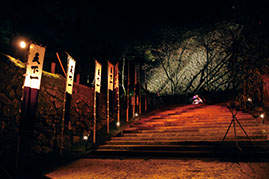Noh artists perform in front of the “Killer Stone Wall of a Thousand Invaders”
The Nobeoka Tengaichi Takigi Noh Theater, a world class traditional Japanese play put on at the outer courtyard of Nobeoka Castle’s ruins every October, uses ancient Noh masks which were handed down from Nobeoka's previous feudal lords, the Naito family. This Noh play, performed by firelight in front of a stone wall called “Killer Stone Wall of a Thousand Invaders,” draws the audience into a mysterious world.
http://www.nobeoka-tengaichi.jp/
The Naito Memorial Hall
This hall was built at the ruins of the palace of the Naito family, the last lords of Nobeoka Castle. The hall houses a variety of artifacts from Nobeoka’s history: Noh masks, calligraphy, paintings, and daily tools from the Taisho and Showa eras.
Closed for rebuilding

DetaildMAP D-3
Bonsho “Bell of Shiroyama”
The “Bell of Shiroyama” was donated to Imayama hachi-man-gu Shrine in 1656 by Yasuzumi Arima, who was then lord of Nobeoka Castle. It was used from the 11th year of the Meiji era (1878) to the 32nd year of the Showa era (1957). It is also the oldest relic that refers to the city of “Nobeoka.”

Tengaichi Noh Masks
66 Noh masks were donated to the Naito Memorial Hall by the Naito family,
including 30 masterpieces by 6 craftsmen who have received the title of “Tengaichi”, the best in Japan, at their trade. This collection is considered extremely valuable all over Japan.


You can witness the authentic
Kagura Festival!
Shimanoura Island residents come together
to celebrate as one.
The Festival is held in November at the ruins Nobeoka Castle. It features Kagura performances in and out of the prefecture, including mountain and ocean. And some performances also invite audience participation.
This two-day festival is held under the moonlight in November. On the first night, an object of worship is offered at a “sacred place." The second night features a boat parade and Kenka(fighting) Mikoshi.
Shiroyama Kagura Festival
Shimanoura Grand Autumn Festival

DetaildMAP D-4
MAP C-8
Saigo Takamori Encampment Museum
It is said that Saigo’s men fled to Kitagawa during the decisive Wadagoe Battle and formed an encampment at this site. Some of Saigo Takamori’s personal belongings and military items are exhibited here.
Fee: General admission: 200 yen,
Elementary and middle school student: 100 yen
Close:Monday


MAP C-5
Gourmet, Scenery
Ayu Fish Trap
“Ayu Yana” is the name of a traditional fishing method that uses a trap to catch fish as they swim downstream to lay their eggs. It controls the flow of water and guides Ayu onto the trap, which is made of bamboo. This method has been used for over 300 years and has become a signature autumn feature in Nobeoka. Measured by both scale and number of fish captured, this trap is the largest in Japan.
*The Ayu Fish Trap season is between October 1st and early December.

Longest fish trap in Japan!
DetaildMAP H-2


OchiAyu
Ayu that swim downstream to lay their eggs are called “Ochi Ayu”. You can also see people catching Ayu at the trap!

IseEbi
Japanese Spiny Lobster
Spiny lobsters from the Hyuga-nada sea
are famous nationwide.
September to mid-April is lobster season and many spiny lobsters can be found in ports all around Nobeoka. Spiny lobsters caught in Nobeoka have a fresh and rich taste. The best way to prepare spiny lobsters is to grill them with salt or eat them raw as sashimi.

Eastern Kyushu Ise Ebi Sea Line,
Ise Ebi Festival
This festival is held for three months from September. Diners can enjoy fresh Ise Ebi at reasonable prices at restaurants along the road that connects Nobeoka City and Saiki City in Oita Prefecture.

Hama Yaki Grill
You can dine on bounty from the sea grilled to perfection.
Fresh fish are loaded from nearby ports; and you can enjoy the exciting way it's charcoal grilled right in front of you.

Autumn Leaves at Shishigawa Valley
Beautiful, vivid autumn foliage!
This valley features magnificent combination of clear water stream and granite rocks. The scenery of water, rocks and autumn leaves is absolutely beautiful.



MAP C-2
Nobeoka Tourist Association
TEL:0982-29-2155
Hours: 9:00am - 5:00pm / Closed: Sat, Sun, and holidays
Address: Cocoretta NOBEOKA 2F,
2-125, Saiwai-machi, Nobeoka City
Nobeoka Souvenir Station
TEL:0982-32-3706
Hours: 8:30am - 5:30pm / Open year around
Address: JR Nobeoka Station
Copyright © Nobeoka Tourist Association All Rights Reserved.


